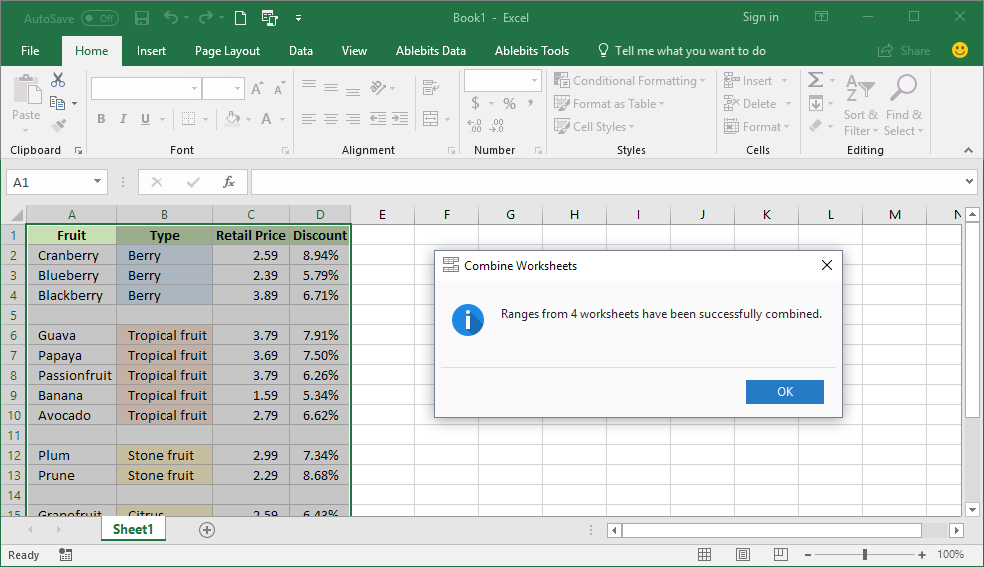5 Ways to Merge Excel Sheets into One Table

Managing multiple Excel spreadsheets can be overwhelming, especially when you need to consolidate data into a single, coherent table. Whether you're a data analyst, business manager, or just someone dealing with lots of spreadsheets, learning how to merge Excel sheets into one table can significantly streamline your work process. Here are five effective methods to achieve this:
1. Manual Copy and Paste


While it might seem basic, this method can be effective for a small number of sheets:
- Open the Excel workbook containing your spreadsheets.
- Select and copy all the data from one sheet.
- Paste this data into your destination sheet.
- Repeat for all necessary sheets, ensuring you paste in the correct order.
2. Using the Consolidate Tool

Excel’s Consolidate feature can help if your data is organized similarly across sheets:
- Select the cell in your new table where you want the consolidated data to begin.
- Go to the ‘Data’ tab, choose ‘Consolidate’.
- Choose your function (e.g., Sum, Average), then select ‘Reference’ to pick your sheets one by one.
- Click ‘Add’ after selecting each sheet, then ‘OK’ to finalize.
📌 Note: The Consolidate function works best with similarly structured data.
3. Power Query


For those dealing with complex datasets or multiple files:
- Open Excel and go to the ‘Data’ tab, select ‘Get Data’ then ‘From File’ > ‘From Workbook’.
- Navigate to your Excel file, select it, and choose the sheets you wish to merge.
- Use the ‘Append Queries’ option in the ‘Home’ tab of Power Query Editor to combine the data.
- Load the results into Excel for further manipulation.
4. Vlookup with Multiple Sheets

If you’re looking to match and pull data from one sheet to another:
- In your master sheet, use the formula:
=VLOOKUP(lookup_value, [SheetName!range], column_index, FALSE)🔍 Note: VLOOKUP can be slow with large datasets. Consider INDEX MATCH for better performance.
5. VBA Script for Advanced Merging


For the more technically inclined, VBA can automate the merging process:
- Press Alt + F11 to open the VBA editor.
- Insert a new module and paste the following code to merge all sheets:
Sub MergeAllWorksheets() Dim ws As Worksheet Dim wsMaster As Worksheet Dim r As Range Set wsMaster = ThisWorkbook.Sheets.Add wsMaster.Name = “Merged_Data”For Each ws In ThisWorkbook.Sheets If ws.Name <> wsMaster.Name Then ws.UsedRange.Copy Destination:=wsMaster.Cells(wsMaster.UsedRange.Rows.Count + 1, 1) End If Next ws
End Sub
Wrapping up this tutorial, the ability to merge Excel sheets into one table not only saves time but also helps in data analysis, reporting, and maintaining a clear overview of your information. Whether you use basic copy-pasting, leverage Excel's inbuilt tools like Consolidate or Power Query, apply functions like VLOOKUP, or automate with VBA, the choice depends on your data's complexity and your familiarity with Excel. Each method has its strengths, ensuring you have a versatile toolkit for all your Excel needs.
Can I merge sheets from different workbooks?

+
Yes, you can merge sheets from different workbooks. With Power Query or VBA, you can import and combine data from multiple Excel files seamlessly.
Is there a limit to the number of sheets I can consolidate?

+
There’s no inherent limit in Excel regarding the number of sheets you can consolidate, but large datasets or many sheets might slow down your Excel application.
What if my data doesn’t align perfectly for merging?

+
If your data structures vary, consider cleaning or reorganizing your sheets beforehand. Alternatively, use Power Query to shape your data before merging.



